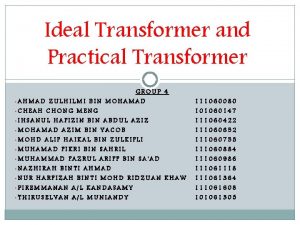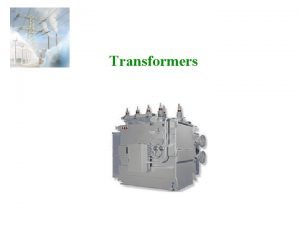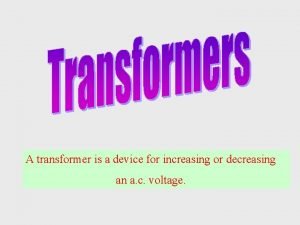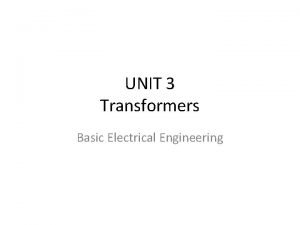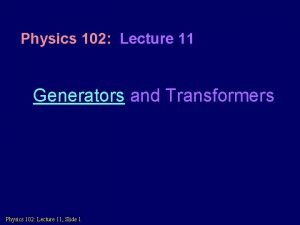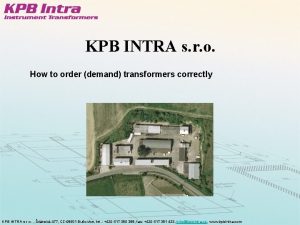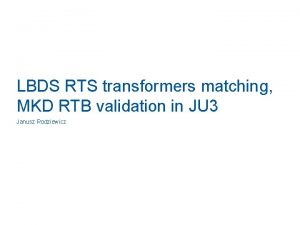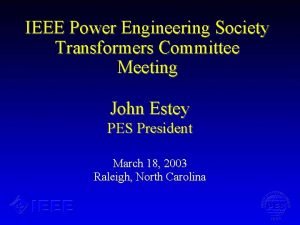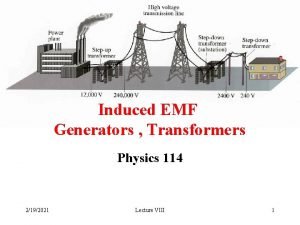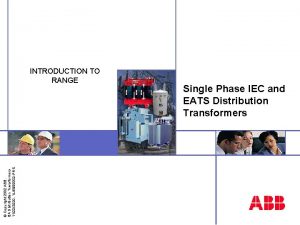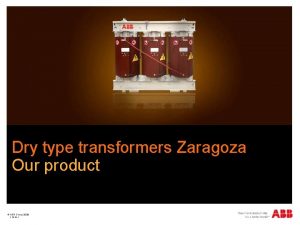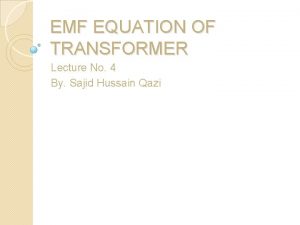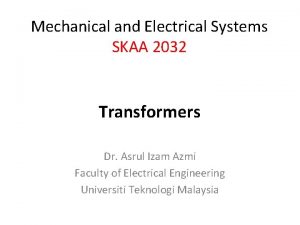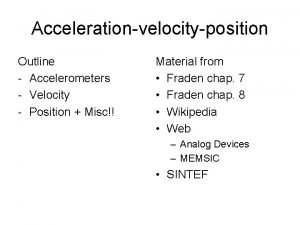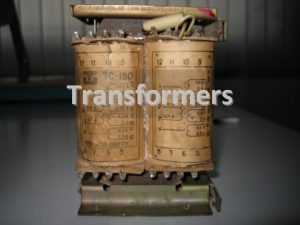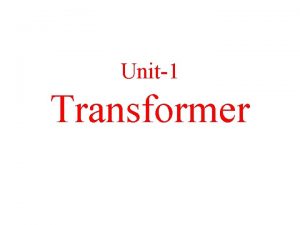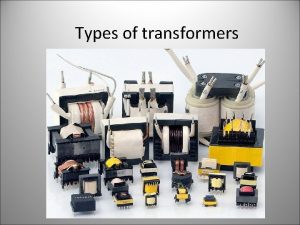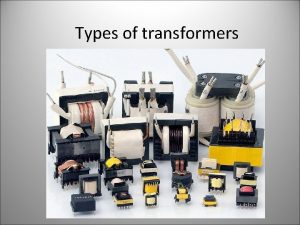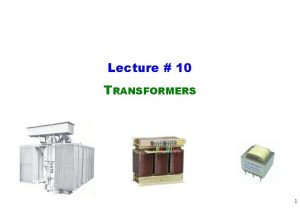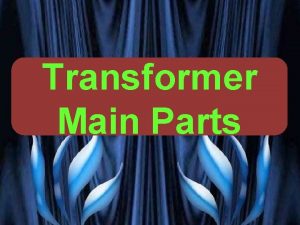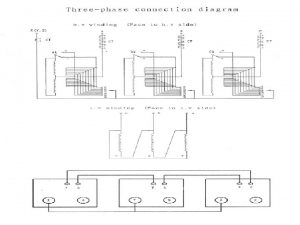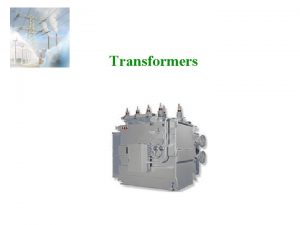Transformers Transformer It is a static device It




































- Slides: 36

Transformers

Transformer Ø It is a static device. Ø It transfers electrical energy from one electrical circuit to other with desired change in voltage and current, without changing the frequency(f=50 Hz) and power. Ø Constant flux device Ø Magnetically coupled and electrically isolated Ø Electro magnetic conversion device.

Principle of operation It is based on principle of MUTUAL INDUCTION. According to which an e. m. f. is induced in a coil when current in the neighbouring coil changes.



Constructional detail : Shell type Ø Parallel magnetic circuit Ø Windings are wrapped around the central limb of a laminated core. Ø Sandwitch winding to reduce the leakage flux Ø Less amount of copper & more amount of insulation is required

Constructional detail : Core type Ø Series magnetic circuit Ø Windings are wrapped around two sides of a laminated square core. Ø More amount of copper & less amount of insulation is required. Ø Economical for high voltage applications

Sectional view of transformers Note: High voltage conductors are smaller cross section conductors than the low voltage coils

Core type Fig 1: Coil and laminations of core type transformer Fig 2: Various types of cores

Shell type Fig: Sandwich windings • The HV and LV windings are split into no. of sections • Where HV winding lies between two LV windings • In sandwich coils leakage can be controlled

Cut view of transformer

Transformer with conservator and breather

Working of a transformer 1. When current in the primary coil changes being alternating in nature, a changing magnetic field is produced 2. This changing magnetic field gets associated with the secondary through the soft iron core 3. Hence magnetic flux linked with the secondary coil changes. 4. Which induces e. m. f. in the secondary.


Ideal Transformers • Zero leakage flux: -Fluxes produced by the primary and secondary currents are confined within the core • The windings have no resistance: - Induced voltages equal applied voltages • The core has infinite permeability - Reluctance of the core is zero - Negligible current is required to establish magnetic flux • Loss-less magnetic core - No hysteresis or eddy currents

Ideal transformer V 1 – supply voltage ; V 2 - output voltgae; Im- magnetising current; E 1 -self induced emf ; I 1 - noload input current ; I 2 - output current E 2 - mutually induced emf

Phasor diagram: Transformer on Noload

Transformer on load assuming no voltage drop in the winding Fig shows the Phasor diagram of a transformer on load by assuming 1. No voltage drop in the winding 2. Equal no. of primary and secondary turns

Transformer on load Fig. a: Ideal transformer on load Fig. b: Main flux and leakage flux in a transformer

Equivalent circuit of a transformer No load equivalent circuit:

Equivalent circuit parameters referred to primary and secondary sides respectively

Transferring secondary parameters to primary side Cu loss after transfer = cu loss before transfer Where R 21 - Equivalent secondary resistance w. r. t primary R 01 = R 1 + R 21 Where R 01 – Total primary resistance referred to secondary

Equivalent circuit referred to primary side :

Transferring primary parameters to secondary side : Cu loss after transfer = cu loss before transfer = k 2 R 1 Where R 11 - Equivalent primary resistance w. r. t secondary R 02 = R 2 + R 11 Where R 01 – Total secondary resistance referred to primary

Equivalent circuit referred to secondary side :

Equivalent circuit w. r. t primary : where

Approximate equivalent circuit Since the no load current is 1% of the full load current, the no load circuit can be neglected

Transformer Tests • The performance of a transformer can be calculated on the basis of equivalent circuit • The four main parameters of equivalent circuit are: - R 01 as referred to primary (or secondary R 02) - the equivalent leakage reactance X 01 as referred to primary (or secondary X 02) - Magnetising susceptance B 0 ( or reactance X 0) - core loss conductance G 0 (or resistance R 0) • The above constants can be easily determined by two tests - Oper circuit test (O. C test / No load test) - Short circuit test (S. C test/Impedance test) • These tests are economical and convenient - these tests furnish the result without actually loading the transformer Electrical Machines

Open-circuit Test In Open Circuit Test the transformer’s secondary winding is open-circuited, and its primary winding is connected to a full-rated line voltage. • Usually conducted on H. V side • To find (i) No load loss or core loss (ii) No load current Io which is helpful in finding Go(or Ro ) and Bo (or Xo )

Short-circuit Test In Short Circuit Test the secondary terminals are short circuited, and the primary terminals are connected to a fairly low-voltage source The input voltage is adjusted until the current in the short circuited windings is equal to its rated value. The input voltage, current and power is measured. • Usually conducted on L. V side • To find (i) Full load copper loss – to pre determine the efficiency (ii) Z 01 or Z 02; X 01 or X 02; R 01 or R 02 - to predetermine the voltage regulation

recall Secondary voltage on no-load V 2 is a secondary terminal voltage on full load Substitute we have

Formula: voltage regulation

Transformer Efficiency Transformer efficiency is defined as (applies to motors, generators and transformers): Types of losses incurred in a transformer: Copper I 2 R losses Hysteresis losses Eddy current losses Therefore, for a transformer, efficiency may be calculated using the following: Electrical Machines

Losses in a transformer Core or Iron loss: Total cu losses = = =

Condition for maximum efficiency :

The load at which the two losses are equal = All day efficiency : • All day efficiency is always less than the commercial efficiency
 Transformer static device
Transformer static device Primary and secondary winding of transformer
Primary and secondary winding of transformer Ideal vs practical transformer
Ideal vs practical transformer Hardware output komputer
Hardware output komputer A transformer is a device used to
A transformer is a device used to Formula of voltage regulation
Formula of voltage regulation A transformer is a device used to
A transformer is a device used to A transformer is a device used for
A transformer is a device used for Transformer efficiency calculation
Transformer efficiency calculation Transformers physics
Transformers physics Josipa mokrovića 12
Josipa mokrovića 12 Kpb intra instrument transformers
Kpb intra instrument transformers Peak efficiency index
Peak efficiency index Romans 12 6 8
Romans 12 6 8 Rts transformer
Rts transformer Ieee transformers committee
Ieee transformers committee Grounding transformers
Grounding transformers Transformers physics
Transformers physics Transformers igor
Transformers igor Abb distribution transformers
Abb distribution transformers Aim of transformer
Aim of transformer Transformers
Transformers Abb dry type transformer
Abb dry type transformer Emf equation of transformers
Emf equation of transformers Application of insulator
Application of insulator Functions of transformers
Functions of transformers Wti and oti setting
Wti and oti setting Transformers
Transformers Static detection of unsafe dma accesses in device drivers
Static detection of unsafe dma accesses in device drivers A tagout device is preferable to using a lockout device.
A tagout device is preferable to using a lockout device. Kelompok output device
Kelompok output device Electrical oil services
Electrical oil services Linear variable differential transformer
Linear variable differential transformer Potential transformer definition
Potential transformer definition Transformner
Transformner Half wave rectifier vs full wave rectifier
Half wave rectifier vs full wave rectifier Main components of substation
Main components of substation


